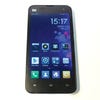Xiaomi MI2 review
Meet the import-only enthusiast's smartphone.
You can't buy the Xiaomi MI2 outside of China, but as smartphones go it's such a remarkable product that we felt that it was worth some serious coverage. Indeed, Xiaomi itself is a fascinating company: little-known outside its homeland, it commands the same kind of reputation and customer commitment that Apple enjoys in the West. There's certainly a synergy in terms of company ethos: Xiaomi builds great products, satisfying and indeed exceeding the expectations of its ever-growing fanbase. The MI2 exemplifies that philosophy. On a physical level, it offers up a state-of-the-art product that holds its own against the likes of the HTC One, but it packs all of that power into a much smaller, more iPhone-like chassis. This is backed up by an innovative, custom OS that ranks as one of the best Android experiences money can buy.
First impressions on opening the box are positive. The MI2 has a very solid, robust chassis that feels dependable and long-lasting although it is clearly built to a cost. The kind of premium finish you get with the iPhone 5 and the HTC One isn't here - what we're dealing with is more akin to the Samsung Galaxy S3, particularly in terms of the plastic rear of the unit. The front of the device is another story though, consisting entirely of Dragontail glass - a competing Japanese version of the industry-standard Gorilla Glass.
The screen itself is a highlight. Sharp provides the 4.3-inch 1280x720 IPS display that offers up a retina-beating 342 pixels per inch. The picture is moderately bright, rich in colour, with temperature and saturation selectables available in the settings menu. It's up there with the iPhone 5's display, though white balance looks a touch off and the gamut isn't quite as wide. Under the screen you'll find three Android navigation buttons (not backlit but fashioned from highly reflective material - so easy to find in most lighting conditions). Under the home button is a multi-colour LED, illuminating for notifications and charging - again, the colours here can be adjusted in the settings. In addition to the front-facing camera, light and proximity sensors are also found here.
The rear plastic shell is a bit of a fingerprint magnet, but on our unit at least it's white in colour, so the smudges don't particularly show in the same way as something like the PlayStation Vita. You can always replace this element too if you want; there are even iPhone 5 clone back covers if you really want them. Removing the rear completely offers up our first big surprise - inside there's a 2000mAh battery that you can easily swap out. There's also a standard-sized SIM slot, meaning no rushing about replacing your card for a micro or nano variant. The only disappointment is the lack of MicroSD slot - so think carefully about storage space when considering a purchase. The MI2 is available in both 16GB and 32GB configurations.
Overall, the form factor of the Xiaomi MI2 is pleasing. It doesn't really rank alongside the premium devices out there but then its asking price is much, much lower and in term of its technological make-up it's got it where it counts. Battery life in particular is pretty impressive: we got six hours, 43 minutes of 720p video playback with screen and volume at 45 per cent - with 9 per cent battery capacity left at the end of the test. With light usage (25 minutes talk-time, 1.5 hours of downloading, 40 minutes of gaming, 3G always on), the battery lasted over three days, so we'd imagine that the standard battery should easily cope with a day of more strenuous activity.
Introducing MIUI
On top of the excellent spec and the basic value proposition, one of the key selling points of the MI2 is the MIUI 5 operating system. It's based on Android 4.1 but it's in a state of continual customisation. At the most basic level you get one of the most in-depth Android experiences on the market with unparalleled levels of customisation out of the box, but at the same time there's the ease of use and intuitive nature you'd usually associate with an iOS device.
By default you get an iPhone-style launcher, and you can customize the size of the grid and add widgets. Not impressed with the default look of the OS? No problem, the whole system supports themes that can completely change the look and feel of it. And if that level of customisation isn't impressive enough, you can mix and match elements of different themes, including icons, additional home screen layouts, sounds, wallpapers, notification drawer styles and much more.
You get some really useful apps by default, plus some genuinely useful, innovative functionality like the permission manager for apps. Let's say you've downloaded a game and it suddenly requests to send an SMS - you'll get a pop-up asking whether you want it to happen or not. Malware is a genuine threat on Android but this helps keep you fully in control. MIUI 5 also includes a network firewall, a call firewall with black lists, call recording and a lot of other decent stuff too.
Other highlights include the music app - it downloads covers and lyrics, scrobbles to last.fm, and offers some useful lock-screen controls. Streaming music and video is also available but right now it's tied to Chinese services. More usefully, you also get a Dolby Mobile equaliser and presets. Outside of audio, the compass reveals pressure and altitude in addition to direction, there's a built-in file manager with FTP sharing, plus there's Wi-Fi sharing and integration with Xiaomi's own cloud drive (offering 5GB of storage). On top of that, a built-in back-up utility is included, plus password manager, anti-virus and so forth. On a more practical level, there's also a flashlight app that you can also activate from lock screen by holding the home key.
Initial set-up is carried out in English, but you will have to remove some bloatware including Chinese chat programs and video services. More importantly, you don't get Google functionality out of the box, but this is easily remedied by going into the market app and downloading Google Play from there. But even with that you don't get some small integration features like uploading to Picasa and YouTube, so you'll need to download the specific YouTube and Google Plus apps (or you can gain a root access and replace one file in the system). Other localisation issues include a beautiful weather app that only shows Chinese weather, plus a voice assistant who speaks Mandarin. Thankfully, that can be changed to Google's own service.
Another feature we really liked was support for over-the-air firmware updates. Basically the phone has two systems installed, one active and another as back-up. When you update your phone it downloads and installs the new OS in the background to the second system. Reboot and you activate the new update with all your existing settings and data in place. If you're not happy with that for whatever reason, the backup is always there, meaning you can reboot to the old OS set-up whenever you want.
Camera and video: enthusiast-friendly
On the surface, the MI2's camera specs are hardly extraordinary but the headline figures don't even tell half of the story. What we're looking at here is a rear-mounted eight-megapixel snapper with autofocus and LED flash - effectively the same camera set-up as the iPhone 4S, but with different optics. On the front of the device, we have a smaller two-megapixel camera which is absolutely fine for video calls, with both cameras offering up 1080p30 video recording. Features include geo-tagging, touch focus, face detection, image stabilisation, HDR and panoramic photography. So far, so good.
Dig deeper and we find some lovely enthusiast features, beginning with 27mm wide-angle optics and a large F2.0 aperture that produces nice depth-of-field effects. If you're looking to capture that perfect moment in your stills, the MI2 can shoot continuously at 8FPS. While the camera produces adequate results in default mode, you can also activate pro-level functions that offer much, much more including grids, custom ISOs, exposure controls, white balance, sound shutter and other features. The overall impression we get is of a company that has taken an off-the-shelf component and given it some genuine love. Results won't best a DSLR or a decent point-and-shoot, but give it some decent light and you can achieve some good results, as the shots below demonstrate.
It's in the area of video where Xiaomi has really pushed the boat out. You get the standard 1080p video recording at 30FPS on both front and rear cameras, but beyond that you can also record 720p at both 60 and 90FPS. In a world where most broadcast transmission and internet video is pegged at 30FPS or below, this might sound like complete overkill but sooner or later physical resolution will level out and from there we'll be moving onto improvements elsewhere, with frame-rate the prime contender. The faster frame-rates also have genuine applications in the 30FPS world too - specifically, high-speed recordings can be played back at the slower frame-rate to give impressive slow-motion recordings. There's also time-lapse video functionality thrown into the mix. All told, these are high-end features typically reserved for dedicated devices like the GoPro Hero series of cameras - to get it as an added bonus in a keenly-priced smartphone is not to be sniffed at.
"The superb camera features sum up the ethos behind this product - off-the-shelf architecture with a strong focus on enthusiast-pleasing levels of customisation."




Benchmarks: better than Nexus 4?
We've updated the way we benchmark Android phones, with a couple of thoughts in mind. Firstly, we wanted to show performance in context of hardware you might already own, not just the latest and greatest devices we've reviewed recently. So for that reason, the Samsung Galaxy S2 and the international version of the S3 (as sold in the UK) are added alongside the existing Tegra 3-powered HTC One X.
Secondly, we've added the new GPU workouts from GLBenchmark 2.7 along with the new 3DMark tool. These new tests are significant in that they are designed to scale across both mobile and traditional desktop/laptop hardware. Next time you hear about "console-level" performance from a smartphone, check this out. The truth is that even the latest devices like the HTC One, Nexus 4 and the Xiaomi MI2 only offer about a third of the raw power of the Intel HD 4000 in the Surface Pro tablet, which in itself still falls short significantly of the Xbox 360 GPU. Overpowering console graphics power in a smartphone is inevitable, but it'll take Tegra 5 or perhaps PowerVR Rogue to make that happen.
Since we have a big bunch of graphics benchmarks, we thought we'd add in Geekbench - a pure CPU test - to add to our combined functionality tests in the form of Quadrant and Antutu. So, let's see how all of this data stacks up.
Both Quadrant and AnTuTu throw up some interesting metrics. Specifically, that despite featuring the exact same Qualcomm APQ8064 Snapdragon processor, the Xiaomi MI2 outpaces the Nexus 4 considerably, occupying a midway point between the Google-branded device and the state-of-the-art HTC One. This must surely be down to surrounding components - memory and storage - since otherwise the devices are very, very similar. Geekbench confirms that the Nexus 4 and MI2 have much the same computational grunt, and here we also see the advantage brought about by the increase of clock-speed to the same CPU cores found in the One.
"The benchmarks demonstrate how the MI2 competes with the best of the best - and how far behind last year's phones compare to today's top-end offerings."
| Xiaomi MI2 | Nexus 4 | HTC One | HTC One X | Galaxy S2 | Galaxy S3 | |
|---|---|---|---|---|---|---|
| Quadrant Standard | 7603 | 4906 | 12488 | 4870 | 3920 | 5127 |
| AnTuTu Benchmark | 21528 | 10580 | 24374 | 11065 | 10270 | 11950 |
| Geekbench | 2321 | 2263 | 2816 | 1455 | 1133 | 1716 |
| GLBenchmark Egypt On-Screen/ Off-Screen | 42fps 30fps | 39fps 31fps | 31fps 34fps | 22fps 14fps | 11fps 11fps | 16fps 16fps |
| GLBenchmark T-Rex On-Screen/ Off-Screen | 17fps 13fps | 19fps 12fps | 13fps 15fps | 5fps 8fps | 3fps 5fps | 4fps 6fps |
| 3D Mark Ice Storm 720p/ 1080p | 10157 5790 | 11019 6400 | 10054 6297 | 5878 3350 | 1702 1212 | 3225 2321 |
In terms of GPU performance, let's talk about what on-screen and off-screen actually mean in relation to the GLBenchmark results. On-screen equates to what you see on the display specific to that device. You'll see that the Nexus 4 is slightly slower than the MI2 - that's because it has a slightly higher resolution. Note also that the MI2 comprehensively bests the One in this metric, despite the HTC's faster processor. The explanation here is simple: the One has a 1080p screen rather than a 720p display. It may have a faster chip than the MI2, but it's got to service 2.5x the amount of pixels.
Off-screen measurements are a leveller - the tests render at 1080p on all devices, also turning off v-sync to push the GPU to its maximum theoretical performance. HTC One obviously wins here but the real-life increase in performance is only in the region of 10 per cent or so. Also take a look at the overall performance of the older devices - Tegra 3 via the HTC One X struggles to keep pace, but the older Galaxies are simply not at the races at all. What we're seeing here is the relentless pace of improving mobile technology and we'll be curious to see how the UK Galaxy S4 stacks up. It uses a 1.9GHz version of the same processor employed in the HTC One (1.7GHz) and the Nexus 4/MI2 (1.5GHz).
In terms of the MI2 and how these benches translate into the actual user experience, we're seeing performance almost as fast as the trend-setting HTC One. Indeed, in graphics tasks, there's more GPU power available to service the smaller screen. In all, the specs suggest a highly compelling proposition.
Gaming performance
The benchmarks throw up few surprises when transposed into the actual gameplay experience. The MI2 is effectively as capable as the latest and best smartphones in dealing with the most demanding 3D games. To put some kind of metric to that, we installed the Google Play app FPS Meter on the MI2 - it's effectively FRAPS for Android, producing an on-screen frame-rate counter along with an average FPS running total. It requires root access to the device, but that's no problem with the MI2 - it's a smartphone that positively begs to be hacked around with.
Real Racing 3 operates at native 720p resolution and offers up a good ballpark 30FPS experience during gameplay, with more stutter introduced during the graphically intensive replays. Modern Combat 4 is mostly very playable, coming in at the same level of performance - again at native resolution. The graphically intensive Need for Speed: Most Wanted sails well north of 30FPS, averaging at around 45-50FPS but with variable performance. Finally, our old favourite, NOVA 3, known for bringing many a mobile GPU to it kness, again hits a fairly sustained 30FPS, though complex effects work sees a hit to performance.
"The MI2 produced very good performance with just about taxing 3D game we could throw at it. Older releases offer up super-smooth 60FPS gameplay."
These titles represent a pretty comprehensive workout for the hardware and it's pretty much the same kind of experience you'll get on the best Android phones elsewhere. Highly variable frame-rates are a bit of a pain but that's the nature of the beast. Drop back to older 3D titles though - we tried Sonic the Hedgehog 4: Episode 2 - and it's a silky, sustained 60FPS. It goes without saying that in common with most modern smartphones, 2D performance isn't an issue whatsoever.
Xiaomi MI2: the Digital Foundry verdict
Why did we seek out the Xiaomi MI2 in the first place? The truth is that there's a massive hole in the Android market for a smartphone packing the latest processing technology but competing with the iPhone 5 in terms of form factor. The Nexus 4 and HTC One are fantastic devices, but they are somewhat on the large side and won't be practical for everyone, not least because they're rather cumbersome for users with smaller hands. In this respect, the MI2 is a winner, effectively miniaturising the Nexus 4 spec into a smaller package without having to compromise in terms of battery power or performance. Indeed, as the specs demonstrate, the MI2 actually outperforms the Nexus in elements outside of the main processor. To the best of our knowledge, there's nothing in the West that offers this package, the only alternative being another Chinese import - the Meizu MX2 - which isn't so compelling with its own locked-down Android OS.
With no real Android competitor in its own space, the MI2's best point of comparison in terms of form factor is indeed the iPhone 5. In all dimensions, the Android device is a few millimetres larger - most notably in terms of thickness - and it's heavier too, at 145g up against the Apple device's more svelte 112g (indeed, it's a touch heavier than the HTC One). Build quality is also a big differentiating factor, effectively coming down to a choice between metal and plastic. But let's remember that we're also dealing with a device that's a fraction of the price with pretty decent battery life. Being able to swap batteries is useful and there's even a larger cell available too - a 3100mAh offering from Xiaomi itself - though this does add further to the thickness of the device.
We also rather like MIUI. It's been described as the best of both worlds - a merging of Android and iOS functionality - and it lives up to its billing. Fast, smooth and easy to use with a colossal array of in-depth features for those who really want to get the best out of their phones, Xiaomi is punting out new betas every week and improving English support. Where once Xiaomi was very China-centric in its outlook and customer service, we get the sense that it's readying itself for marketing its wares to the wider world. If that comes to pass, we wish the company well - the Xiaomi MI2 is a product that carves out its own niche, and with the right marketing and pricing, it could be very successful.


















































